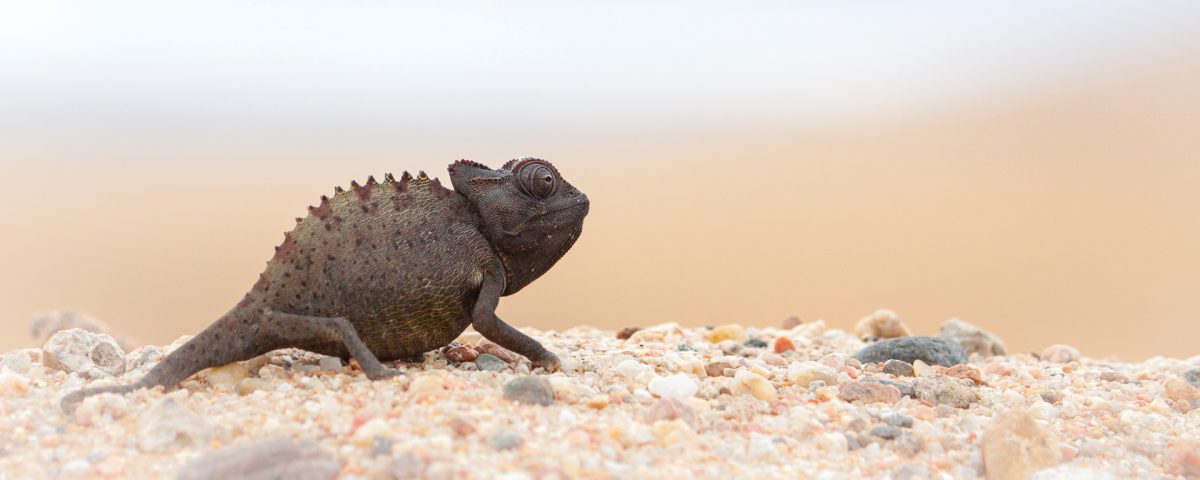Compiled Sanet van Zijl | Main photo: Namaqua Chameleon ©Annabelle Venter
Previously we looked at the Lagoon Five, now we’re moving on to the Dune Five. This list includes some tiny critters that are too often overlooked when visiting the dunes of the Namib Desert.
Namibia is home to various distinctive groups of animals, such as the Desert Four which comprises desert adapted lion, elephant, giraffe and rhino. The Dune Five can be seen on explorations of the Namib, such as on Living Desert Tours.
1. Shovel Snouted Lizard – This duck-faced lizard is endemic to the Namib and can be found along the soft slip faces of dunes. It buries itself under the surface of the sand when it feels threatened, which has lead to its other name, the Sand Diving Lizard. By doing a slow dance this animal copes with the hot desert sand. It lifts to feet in the air at a time, holding it up for a few seconds and then it alternates to the other two feet.
2. Sidewinder Snake – An endemic to Namibia, this snake is one of the smallest adders in the world. It grows up to only 30 cm and has eyes on top of its head allowing it to burrow into the sand and have eyes above the surface. This is how it hunts, only its eyes and the tip of its tail are left exposed. It uses the tiny black point of its tail to mimic an insect and attract lizards. Its side-winding motion allows it to keep most of its body off of the ground at all times in order to avoid the scorching sand.
3. The Namaqua Chameleon – In the desert this colour-changing animal spends most of its life on the ground hunting for insects. These are some of the fastest moving chameleons in the world and they can grow up to 30 cm in size. Throughout the day their skin is a dark black colour, but they will change their colour according to their mood or if they feel threatened. The darker colour helps them to absorb the heat of the sun in the mornings, allowing them to move faster when they hunt. During the hottest parts of the day it changes to a lighter colour to reflect the sun and avoid overheating. The chameleon’s skin will turn deep black if it feels angry or nervous. Its eyes can rotate independently from one another and each one can swivel 180 degrees. Upon spotting an insect to eat, it will focus both eyes on the prey. Its sticky tongue, which is as long as its body and tail combined, is used to snatch up food.
4. Palmato Gecko – This critter is another endemic to the Namib. Alternatively, it is known as the Web-Footed Gecko. They are nocturnal with no eyelids and only fixed lens eyes, which they clean by constantly licking them. Their webbed feet spread their weight evenly over the sand, giving them traction. Their skin is translucent, so much so that you can see their blood vessels. They come in a variety of patterns and colours. Most of the moisture they need is obtained from their prey, but when there is fog available they stand in an open space and wait for the fog to condense on their bodies and they lick the water droplets off their eyes.
5. Dancing White Lady Spider – This large white spider is also known as the Cartwheeling Spider and is endemic to the Namib dune belt. Its burrow is made out of silk in the slip face of a dune, which it then closes with a trap door. It comes out at night to hunt insects. It curls up into a ball when it feels threatened and cartwheels down the dune slope at 44 rolls per second. This is faster than any of its predators can run.
To go on a Living Desert Adventure you can make a booking at the Adventure and Travel Office at Strand Hotel Swakopmund.




